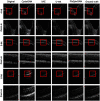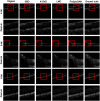High signal-to-noise ratio reconstruction of low bit-depth optical coherence tomography using deep learning
- PMID: 33191687
- PMCID: PMC7666869
- DOI: 10.1117/1.JBO.25.12.123702
High signal-to-noise ratio reconstruction of low bit-depth optical coherence tomography using deep learning
Abstract
Significance: Reducing the bit depth is an effective approach to lower the cost of an optical coherence tomography (OCT) imaging device and increase the transmission efficiency in data acquisition and telemedicine. However, a low bit depth will lead to the degradation of the detection sensitivity, thus reducing the signal-to-noise ratio (SNR) of OCT images.
Aim: We propose using deep learning to reconstruct high SNR OCT images from low bit-depth acquisition.
Approach: The feasibility of our approach is evaluated by applying this approach to the quantized 3- to 8-bit data from native 12-bit interference fringes. We employ a pixel-to-pixel generative adversarial network (pix2pixGAN) architecture in the low-to-high bit-depth OCT image transition.
Results: Extensively, qualitative and quantitative results show our method could significantly improve the SNR of the low bit-depth OCT images. The adopted pix2pixGAN is superior to other possible deep learning and compressed sensing solutions.
Conclusions: Our work demonstrates that the proper integration of OCT and deep learning could benefit the development of healthcare in low-resource settings.
Keywords: computational imaging; deep learning; image and signal reconstruction; ophthalmic imaging; optical coherence tomography.
Figures














